Hydrogen, Fuel of the Future: Engineering Report 2014-2015
VerifiedAdded on 2021/06/07
|20
|7351
|42
Report
AI Summary
This report from the University of Hull's School of Engineering assesses the viability of hydrogen as a primary fuel source, considering its potential beyond the year 2100. The report analyzes various aspects, including hydrogen production methods (biological water splitting, natural gas reforming, and electrolysis), storage, and infrastructure requirements. It compares hydrogen with other renewable energy sources like nuclear, wind, and solar, evaluating their costs and efficiencies. A comparison between hydrogen fuel and oil is made to highlight the advantages of hydrogen. The report also includes a case study on transportation and addresses public acceptance. The conclusion draws on the feasibility of a hydrogen-dominated future, emphasizing the challenges and opportunities associated with transitioning to a hydrogen economy. References and a detailed discussion of the global energy landscape are provided.

School of Engineering
Lecturer Gavin Cutler
Student No:
Module No: 57033
Lecturer Gavin Cutler
Student No:
Module No: 57033
Paraphrase This Document
Need a fresh take? Get an instant paraphrase of this document with our AI Paraphraser

Contents
1.0 Introduction:..............................................................................................................................3
2.0 The cost of Change:.........................................................................................................................4
2.1 Hydrogen:....................................................................................................................................5
2.2 Hydrogen fuel safety:...................................................................................................................8
2.3 Hydrogen vs. Oil:..........................................................................................................................9
2.3.1 For 1 gal of petrol:................................................................................................................9
2.3.2 For 1 kg hydrogen...............................................................................................................10
2.4 Hydrogen storage:.....................................................................................................................11
2.5 Hydrogen Infrastructure:...........................................................................................................12
3.0 Case study: Transportation:...........................................................................................................14
3.1 Public Acceptance:.....................................................................................................................15
4.0 Conclusion:....................................................................................................................................16
5.0 References:....................................................................................................................................18
2
1.0 Introduction:..............................................................................................................................3
2.0 The cost of Change:.........................................................................................................................4
2.1 Hydrogen:....................................................................................................................................5
2.2 Hydrogen fuel safety:...................................................................................................................8
2.3 Hydrogen vs. Oil:..........................................................................................................................9
2.3.1 For 1 gal of petrol:................................................................................................................9
2.3.2 For 1 kg hydrogen...............................................................................................................10
2.4 Hydrogen storage:.....................................................................................................................11
2.5 Hydrogen Infrastructure:...........................................................................................................12
3.0 Case study: Transportation:...........................................................................................................14
3.1 Public Acceptance:.....................................................................................................................15
4.0 Conclusion:....................................................................................................................................16
5.0 References:....................................................................................................................................18
2
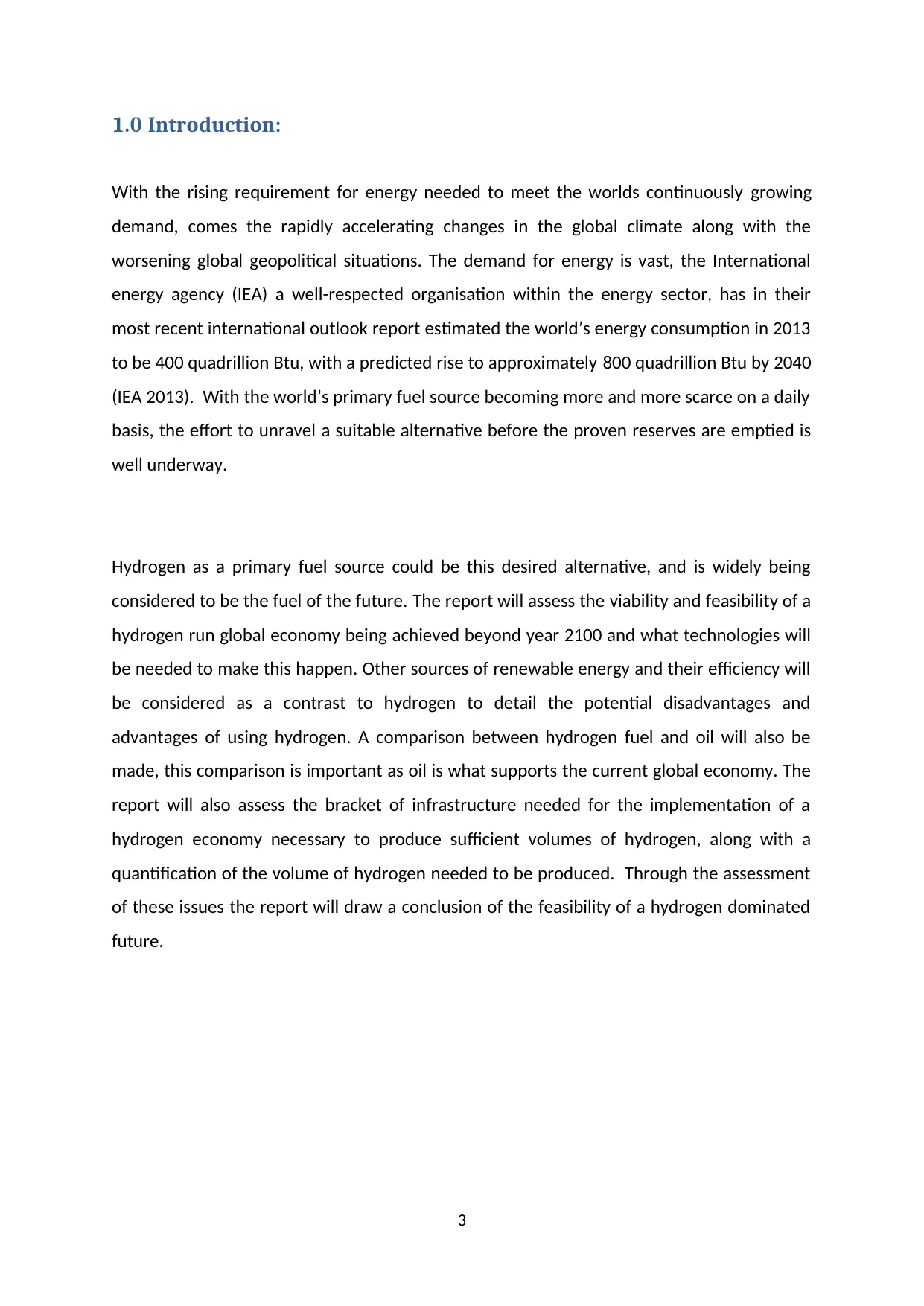
1.0 Introduction:
With the rising requirement for energy needed to meet the worlds continuously growing
demand, comes the rapidly accelerating changes in the global climate along with the
worsening global geopolitical situations. The demand for energy is vast, the International
energy agency (IEA) a well-respected organisation within the energy sector, has in their
most recent international outlook report estimated the world’s energy consumption in 2013
to be 400 quadrillion Btu, with a predicted rise to approximately 800 quadrillion Btu by 2040
(IEA 2013). With the world’s primary fuel source becoming more and more scarce on a daily
basis, the effort to unravel a suitable alternative before the proven reserves are emptied is
well underway.
Hydrogen as a primary fuel source could be this desired alternative, and is widely being
considered to be the fuel of the future. The report will assess the viability and feasibility of a
hydrogen run global economy being achieved beyond year 2100 and what technologies will
be needed to make this happen. Other sources of renewable energy and their efficiency will
be considered as a contrast to hydrogen to detail the potential disadvantages and
advantages of using hydrogen. A comparison between hydrogen fuel and oil will also be
made, this comparison is important as oil is what supports the current global economy. The
report will also assess the bracket of infrastructure needed for the implementation of a
hydrogen economy necessary to produce sufficient volumes of hydrogen, along with a
quantification of the volume of hydrogen needed to be produced. Through the assessment
of these issues the report will draw a conclusion of the feasibility of a hydrogen dominated
future.
3
With the rising requirement for energy needed to meet the worlds continuously growing
demand, comes the rapidly accelerating changes in the global climate along with the
worsening global geopolitical situations. The demand for energy is vast, the International
energy agency (IEA) a well-respected organisation within the energy sector, has in their
most recent international outlook report estimated the world’s energy consumption in 2013
to be 400 quadrillion Btu, with a predicted rise to approximately 800 quadrillion Btu by 2040
(IEA 2013). With the world’s primary fuel source becoming more and more scarce on a daily
basis, the effort to unravel a suitable alternative before the proven reserves are emptied is
well underway.
Hydrogen as a primary fuel source could be this desired alternative, and is widely being
considered to be the fuel of the future. The report will assess the viability and feasibility of a
hydrogen run global economy being achieved beyond year 2100 and what technologies will
be needed to make this happen. Other sources of renewable energy and their efficiency will
be considered as a contrast to hydrogen to detail the potential disadvantages and
advantages of using hydrogen. A comparison between hydrogen fuel and oil will also be
made, this comparison is important as oil is what supports the current global economy. The
report will also assess the bracket of infrastructure needed for the implementation of a
hydrogen economy necessary to produce sufficient volumes of hydrogen, along with a
quantification of the volume of hydrogen needed to be produced. Through the assessment
of these issues the report will draw a conclusion of the feasibility of a hydrogen dominated
future.
3
⊘ This is a preview!⊘
Do you want full access?
Subscribe today to unlock all pages.

Trusted by 1+ million students worldwide
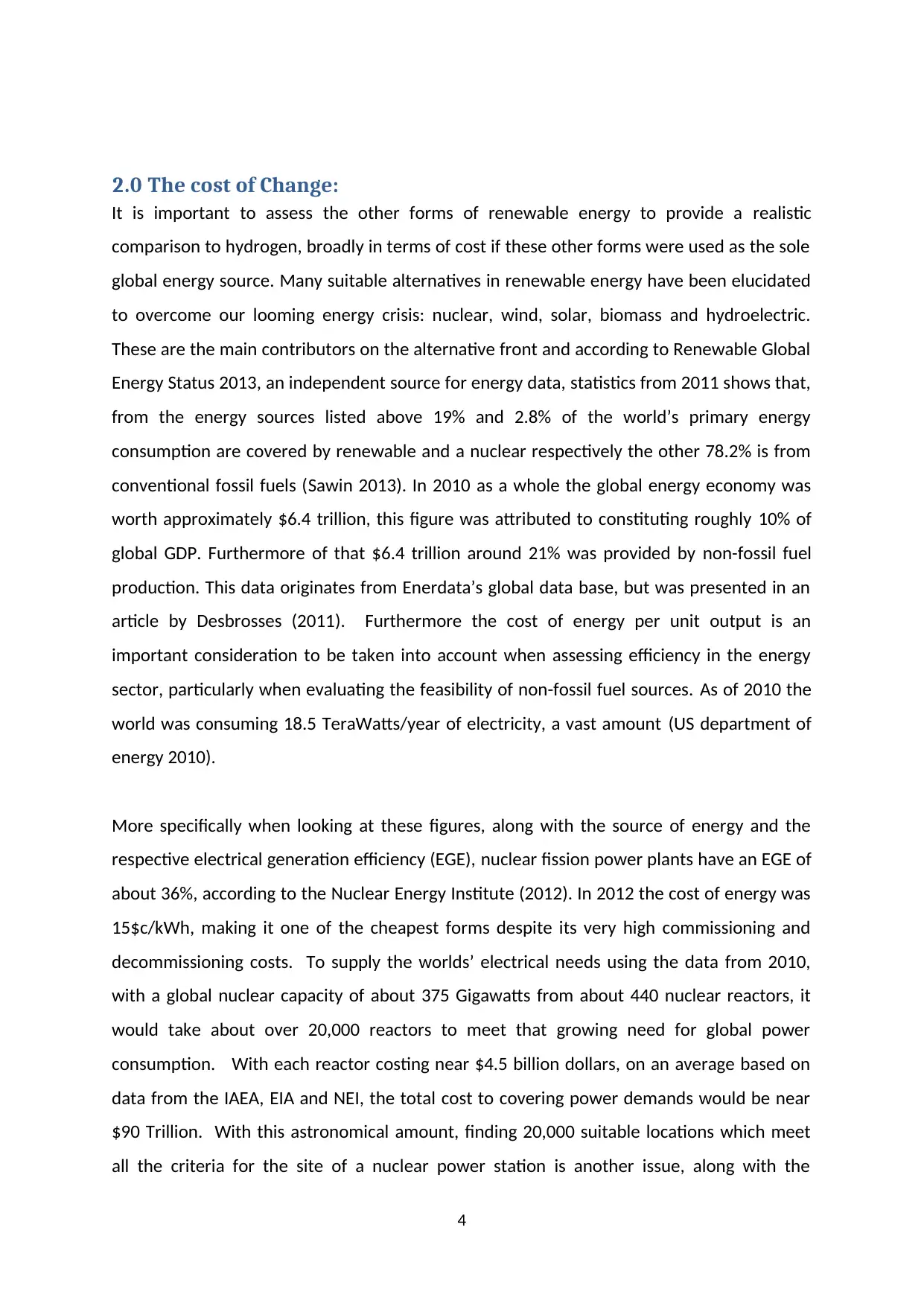
2.0 The cost of Change:
It is important to assess the other forms of renewable energy to provide a realistic
comparison to hydrogen, broadly in terms of cost if these other forms were used as the sole
global energy source. Many suitable alternatives in renewable energy have been elucidated
to overcome our looming energy crisis: nuclear, wind, solar, biomass and hydroelectric.
These are the main contributors on the alternative front and according to Renewable Global
Energy Status 2013, an independent source for energy data, statistics from 2011 shows that,
from the energy sources listed above 19% and 2.8% of the world’s primary energy
consumption are covered by renewable and a nuclear respectively the other 78.2% is from
conventional fossil fuels (Sawin 2013). In 2010 as a whole the global energy economy was
worth approximately $6.4 trillion, this figure was attributed to constituting roughly 10% of
global GDP. Furthermore of that $6.4 trillion around 21% was provided by non-fossil fuel
production. This data originates from Enerdata’s global data base, but was presented in an
article by Desbrosses (2011). Furthermore the cost of energy per unit output is an
important consideration to be taken into account when assessing efficiency in the energy
sector, particularly when evaluating the feasibility of non-fossil fuel sources. As of 2010 the
world was consuming 18.5 TeraWatts/year of electricity, a vast amount (US department of
energy 2010).
More specifically when looking at these figures, along with the source of energy and the
respective electrical generation efficiency (EGE), nuclear fission power plants have an EGE of
about 36%, according to the Nuclear Energy Institute (2012). In 2012 the cost of energy was
15$c/kWh, making it one of the cheapest forms despite its very high commissioning and
decommissioning costs. To supply the worlds’ electrical needs using the data from 2010,
with a global nuclear capacity of about 375 Gigawatts from about 440 nuclear reactors, it
would take about over 20,000 reactors to meet that growing need for global power
consumption. With each reactor costing near $4.5 billion dollars, on an average based on
data from the IAEA, EIA and NEI, the total cost to covering power demands would be near
$90 Trillion. With this astronomical amount, finding 20,000 suitable locations which meet
all the criteria for the site of a nuclear power station is another issue, along with the
4
It is important to assess the other forms of renewable energy to provide a realistic
comparison to hydrogen, broadly in terms of cost if these other forms were used as the sole
global energy source. Many suitable alternatives in renewable energy have been elucidated
to overcome our looming energy crisis: nuclear, wind, solar, biomass and hydroelectric.
These are the main contributors on the alternative front and according to Renewable Global
Energy Status 2013, an independent source for energy data, statistics from 2011 shows that,
from the energy sources listed above 19% and 2.8% of the world’s primary energy
consumption are covered by renewable and a nuclear respectively the other 78.2% is from
conventional fossil fuels (Sawin 2013). In 2010 as a whole the global energy economy was
worth approximately $6.4 trillion, this figure was attributed to constituting roughly 10% of
global GDP. Furthermore of that $6.4 trillion around 21% was provided by non-fossil fuel
production. This data originates from Enerdata’s global data base, but was presented in an
article by Desbrosses (2011). Furthermore the cost of energy per unit output is an
important consideration to be taken into account when assessing efficiency in the energy
sector, particularly when evaluating the feasibility of non-fossil fuel sources. As of 2010 the
world was consuming 18.5 TeraWatts/year of electricity, a vast amount (US department of
energy 2010).
More specifically when looking at these figures, along with the source of energy and the
respective electrical generation efficiency (EGE), nuclear fission power plants have an EGE of
about 36%, according to the Nuclear Energy Institute (2012). In 2012 the cost of energy was
15$c/kWh, making it one of the cheapest forms despite its very high commissioning and
decommissioning costs. To supply the worlds’ electrical needs using the data from 2010,
with a global nuclear capacity of about 375 Gigawatts from about 440 nuclear reactors, it
would take about over 20,000 reactors to meet that growing need for global power
consumption. With each reactor costing near $4.5 billion dollars, on an average based on
data from the IAEA, EIA and NEI, the total cost to covering power demands would be near
$90 Trillion. With this astronomical amount, finding 20,000 suitable locations which meet
all the criteria for the site of a nuclear power station is another issue, along with the
4
Paraphrase This Document
Need a fresh take? Get an instant paraphrase of this document with our AI Paraphraser
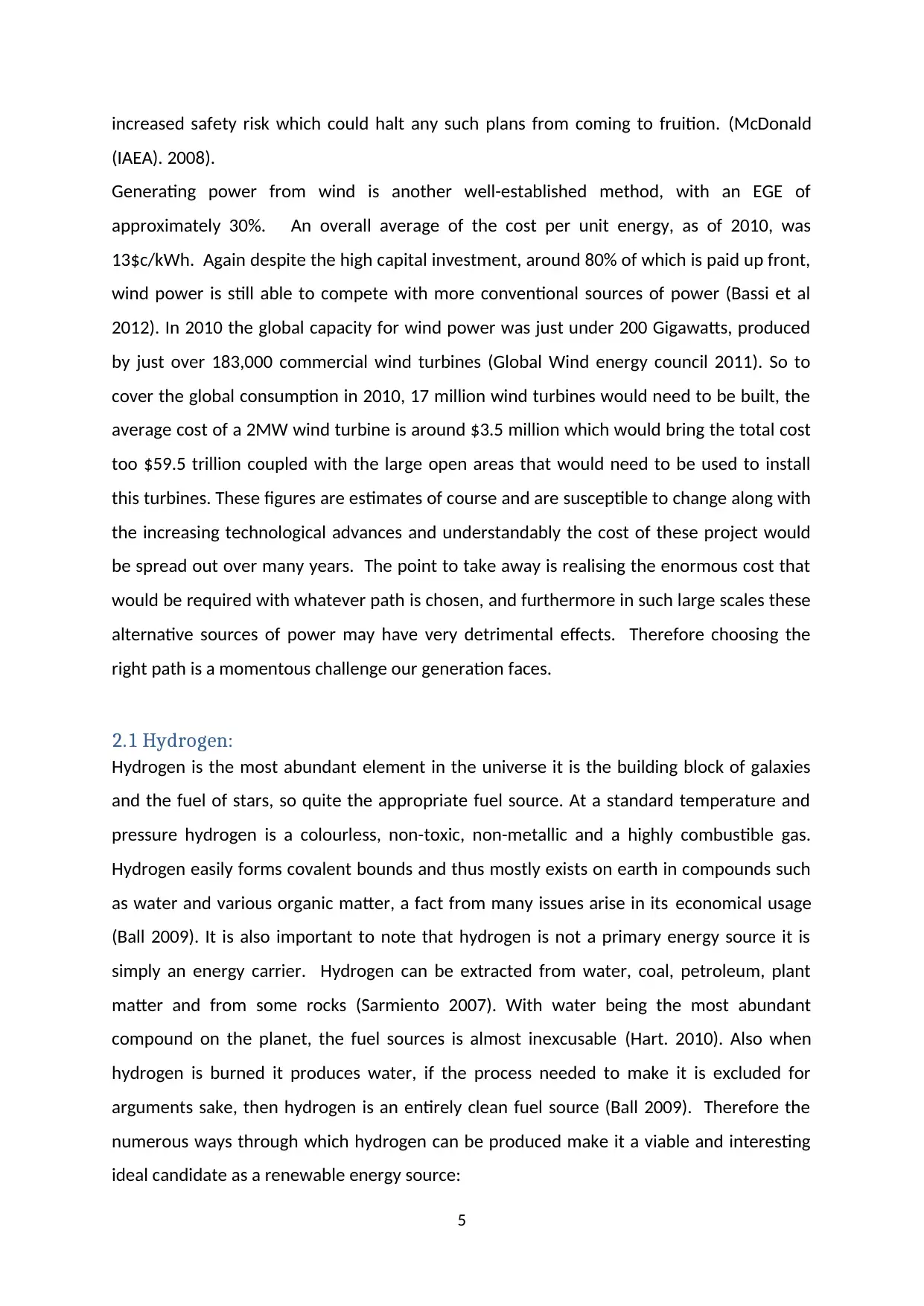
increased safety risk which could halt any such plans from coming to fruition. (McDonald
(IAEA). 2008).
Generating power from wind is another well-established method, with an EGE of
approximately 30%. An overall average of the cost per unit energy, as of 2010, was
13$c/kWh. Again despite the high capital investment, around 80% of which is paid up front,
wind power is still able to compete with more conventional sources of power (Bassi et al
2012). In 2010 the global capacity for wind power was just under 200 Gigawatts, produced
by just over 183,000 commercial wind turbines (Global Wind energy council 2011). So to
cover the global consumption in 2010, 17 million wind turbines would need to be built, the
average cost of a 2MW wind turbine is around $3.5 million which would bring the total cost
too $59.5 trillion coupled with the large open areas that would need to be used to install
this turbines. These figures are estimates of course and are susceptible to change along with
the increasing technological advances and understandably the cost of these project would
be spread out over many years. The point to take away is realising the enormous cost that
would be required with whatever path is chosen, and furthermore in such large scales these
alternative sources of power may have very detrimental effects. Therefore choosing the
right path is a momentous challenge our generation faces.
2.1 Hydrogen:
Hydrogen is the most abundant element in the universe it is the building block of galaxies
and the fuel of stars, so quite the appropriate fuel source. At a standard temperature and
pressure hydrogen is a colourless, non-toxic, non-metallic and a highly combustible gas.
Hydrogen easily forms covalent bounds and thus mostly exists on earth in compounds such
as water and various organic matter, a fact from many issues arise in its economical usage
(Ball 2009). It is also important to note that hydrogen is not a primary energy source it is
simply an energy carrier. Hydrogen can be extracted from water, coal, petroleum, plant
matter and from some rocks (Sarmiento 2007). With water being the most abundant
compound on the planet, the fuel sources is almost inexcusable (Hart. 2010). Also when
hydrogen is burned it produces water, if the process needed to make it is excluded for
arguments sake, then hydrogen is an entirely clean fuel source (Ball 2009). Therefore the
numerous ways through which hydrogen can be produced make it a viable and interesting
ideal candidate as a renewable energy source:
5
(IAEA). 2008).
Generating power from wind is another well-established method, with an EGE of
approximately 30%. An overall average of the cost per unit energy, as of 2010, was
13$c/kWh. Again despite the high capital investment, around 80% of which is paid up front,
wind power is still able to compete with more conventional sources of power (Bassi et al
2012). In 2010 the global capacity for wind power was just under 200 Gigawatts, produced
by just over 183,000 commercial wind turbines (Global Wind energy council 2011). So to
cover the global consumption in 2010, 17 million wind turbines would need to be built, the
average cost of a 2MW wind turbine is around $3.5 million which would bring the total cost
too $59.5 trillion coupled with the large open areas that would need to be used to install
this turbines. These figures are estimates of course and are susceptible to change along with
the increasing technological advances and understandably the cost of these project would
be spread out over many years. The point to take away is realising the enormous cost that
would be required with whatever path is chosen, and furthermore in such large scales these
alternative sources of power may have very detrimental effects. Therefore choosing the
right path is a momentous challenge our generation faces.
2.1 Hydrogen:
Hydrogen is the most abundant element in the universe it is the building block of galaxies
and the fuel of stars, so quite the appropriate fuel source. At a standard temperature and
pressure hydrogen is a colourless, non-toxic, non-metallic and a highly combustible gas.
Hydrogen easily forms covalent bounds and thus mostly exists on earth in compounds such
as water and various organic matter, a fact from many issues arise in its economical usage
(Ball 2009). It is also important to note that hydrogen is not a primary energy source it is
simply an energy carrier. Hydrogen can be extracted from water, coal, petroleum, plant
matter and from some rocks (Sarmiento 2007). With water being the most abundant
compound on the planet, the fuel sources is almost inexcusable (Hart. 2010). Also when
hydrogen is burned it produces water, if the process needed to make it is excluded for
arguments sake, then hydrogen is an entirely clean fuel source (Ball 2009). Therefore the
numerous ways through which hydrogen can be produced make it a viable and interesting
ideal candidate as a renewable energy source:
5
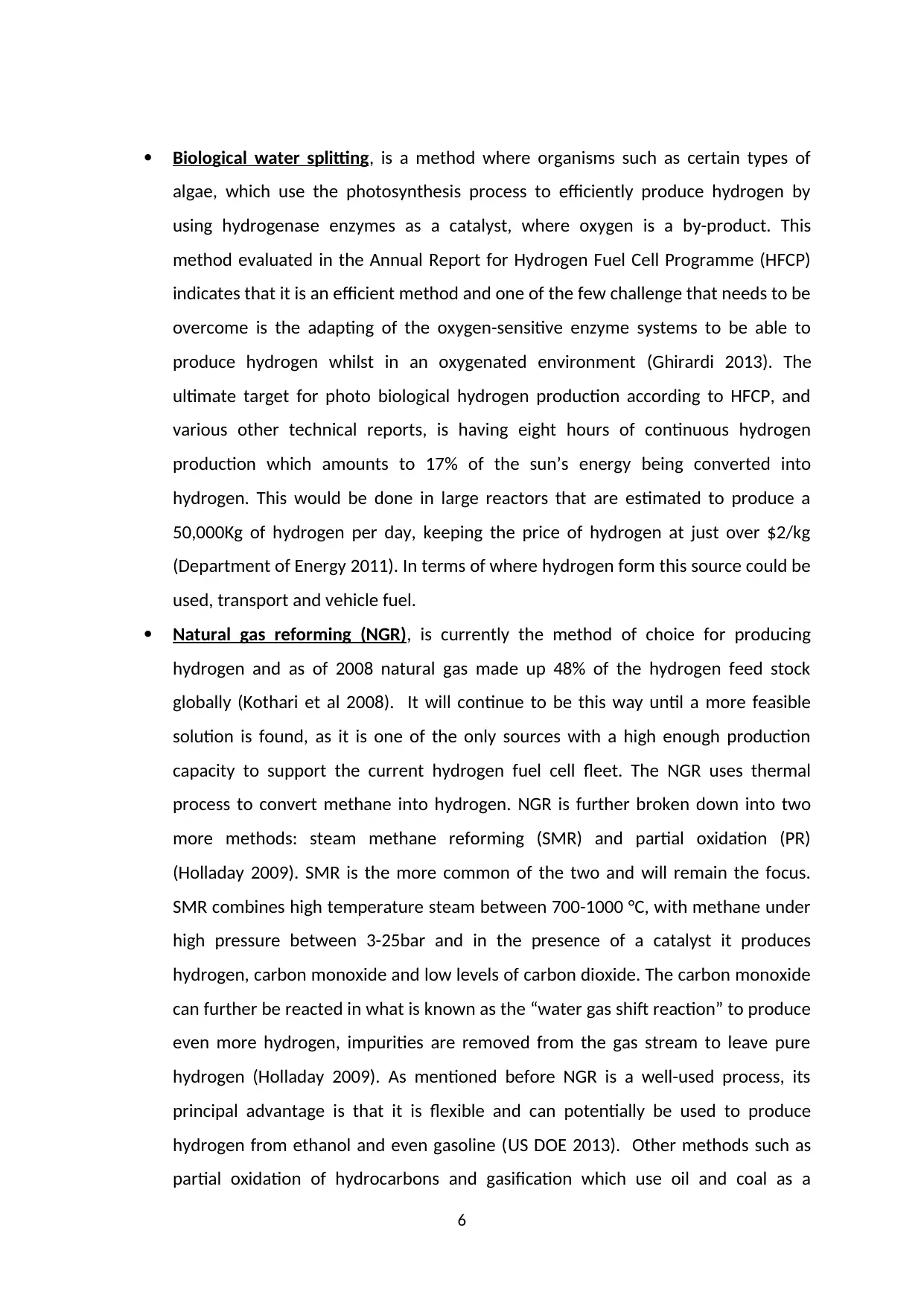
Biological water splitting, is a method where organisms such as certain types of
algae, which use the photosynthesis process to efficiently produce hydrogen by
using hydrogenase enzymes as a catalyst, where oxygen is a by-product. This
method evaluated in the Annual Report for Hydrogen Fuel Cell Programme (HFCP)
indicates that it is an efficient method and one of the few challenge that needs to be
overcome is the adapting of the oxygen-sensitive enzyme systems to be able to
produce hydrogen whilst in an oxygenated environment (Ghirardi 2013). The
ultimate target for photo biological hydrogen production according to HFCP, and
various other technical reports, is having eight hours of continuous hydrogen
production which amounts to 17% of the sun’s energy being converted into
hydrogen. This would be done in large reactors that are estimated to produce a
50,000Kg of hydrogen per day, keeping the price of hydrogen at just over $2/kg
(Department of Energy 2011). In terms of where hydrogen form this source could be
used, transport and vehicle fuel.
Natural gas reforming (NGR), is currently the method of choice for producing
hydrogen and as of 2008 natural gas made up 48% of the hydrogen feed stock
globally (Kothari et al 2008). It will continue to be this way until a more feasible
solution is found, as it is one of the only sources with a high enough production
capacity to support the current hydrogen fuel cell fleet. The NGR uses thermal
process to convert methane into hydrogen. NGR is further broken down into two
more methods: steam methane reforming (SMR) and partial oxidation (PR)
(Holladay 2009). SMR is the more common of the two and will remain the focus.
SMR combines high temperature steam between 700-1000 °C, with methane under
high pressure between 3-25bar and in the presence of a catalyst it produces
hydrogen, carbon monoxide and low levels of carbon dioxide. The carbon monoxide
can further be reacted in what is known as the “water gas shift reaction” to produce
even more hydrogen, impurities are removed from the gas stream to leave pure
hydrogen (Holladay 2009). As mentioned before NGR is a well-used process, its
principal advantage is that it is flexible and can potentially be used to produce
hydrogen from ethanol and even gasoline (US DOE 2013). Other methods such as
partial oxidation of hydrocarbons and gasification which use oil and coal as a
6
algae, which use the photosynthesis process to efficiently produce hydrogen by
using hydrogenase enzymes as a catalyst, where oxygen is a by-product. This
method evaluated in the Annual Report for Hydrogen Fuel Cell Programme (HFCP)
indicates that it is an efficient method and one of the few challenge that needs to be
overcome is the adapting of the oxygen-sensitive enzyme systems to be able to
produce hydrogen whilst in an oxygenated environment (Ghirardi 2013). The
ultimate target for photo biological hydrogen production according to HFCP, and
various other technical reports, is having eight hours of continuous hydrogen
production which amounts to 17% of the sun’s energy being converted into
hydrogen. This would be done in large reactors that are estimated to produce a
50,000Kg of hydrogen per day, keeping the price of hydrogen at just over $2/kg
(Department of Energy 2011). In terms of where hydrogen form this source could be
used, transport and vehicle fuel.
Natural gas reforming (NGR), is currently the method of choice for producing
hydrogen and as of 2008 natural gas made up 48% of the hydrogen feed stock
globally (Kothari et al 2008). It will continue to be this way until a more feasible
solution is found, as it is one of the only sources with a high enough production
capacity to support the current hydrogen fuel cell fleet. The NGR uses thermal
process to convert methane into hydrogen. NGR is further broken down into two
more methods: steam methane reforming (SMR) and partial oxidation (PR)
(Holladay 2009). SMR is the more common of the two and will remain the focus.
SMR combines high temperature steam between 700-1000 °C, with methane under
high pressure between 3-25bar and in the presence of a catalyst it produces
hydrogen, carbon monoxide and low levels of carbon dioxide. The carbon monoxide
can further be reacted in what is known as the “water gas shift reaction” to produce
even more hydrogen, impurities are removed from the gas stream to leave pure
hydrogen (Holladay 2009). As mentioned before NGR is a well-used process, its
principal advantage is that it is flexible and can potentially be used to produce
hydrogen from ethanol and even gasoline (US DOE 2013). Other methods such as
partial oxidation of hydrocarbons and gasification which use oil and coal as a
6
⊘ This is a preview!⊘
Do you want full access?
Subscribe today to unlock all pages.

Trusted by 1+ million students worldwide

feedstock fuel source have a similar process. Overall an average size hydrogen plant
can produce about 135,000kg per day assuming it was working at 90% capacity
(Spath and Mann 2001). The hydrogen from this source is currently and
predominantly used in the oil and gas industry and it will continue to be used there
until it is no longer needed, unlike other sources of hydrogen this is finite, but will
continue to be used for major industrial uses until it becomes no longer viable.
Electrolysis, is a method of obtaining hydrogen using a DC electrical current that
splits down the water into its base elements of hydrogen and oxygen (Mazloomi
2012). The process is simple; an electrolyser which is made up of a membrane lies
between two catalyst-coated electrodes. At the anode, water is split into protons,
electrons, and oxygen. The electrons then move through a circuit under the
influence of an applied electric field and the protons move through the membrane
and combine with electrons at the cathode to form hydrogen (NREL 2003). The only
requirement for this procedure is an electrical power source, where according to a
report from NREL it requires 52.5 kWh to produce 1 kg of hydrogen, this is assuming
a 75% efficiency system based on the higher heating value of hydrogen. (Levene et
al2005) Therefore for a 2MW wind turbine that can produce 2000kW per h on a
fairly windy site can process up too 912kg of hydrogen per day. Using electrolysis
may be the domestic energy source of the future, where houses in rural areas can
become completely independent of Grid systems using this method of producing
hydrogen.
These methods represent the most effective methods for producing fuel from hydrogen on
a large scale, the current method for producing carbon neutral and the future to produce
large quantise of carbon free hydrogen. The scales and methods of production give a clear
introduction as to what stage the transformation from a conventional sources to hydrogen
is at. Until conventional methods are improved and up-scaled, a renewable hydrogen supply
will not be viable.
7
can produce about 135,000kg per day assuming it was working at 90% capacity
(Spath and Mann 2001). The hydrogen from this source is currently and
predominantly used in the oil and gas industry and it will continue to be used there
until it is no longer needed, unlike other sources of hydrogen this is finite, but will
continue to be used for major industrial uses until it becomes no longer viable.
Electrolysis, is a method of obtaining hydrogen using a DC electrical current that
splits down the water into its base elements of hydrogen and oxygen (Mazloomi
2012). The process is simple; an electrolyser which is made up of a membrane lies
between two catalyst-coated electrodes. At the anode, water is split into protons,
electrons, and oxygen. The electrons then move through a circuit under the
influence of an applied electric field and the protons move through the membrane
and combine with electrons at the cathode to form hydrogen (NREL 2003). The only
requirement for this procedure is an electrical power source, where according to a
report from NREL it requires 52.5 kWh to produce 1 kg of hydrogen, this is assuming
a 75% efficiency system based on the higher heating value of hydrogen. (Levene et
al2005) Therefore for a 2MW wind turbine that can produce 2000kW per h on a
fairly windy site can process up too 912kg of hydrogen per day. Using electrolysis
may be the domestic energy source of the future, where houses in rural areas can
become completely independent of Grid systems using this method of producing
hydrogen.
These methods represent the most effective methods for producing fuel from hydrogen on
a large scale, the current method for producing carbon neutral and the future to produce
large quantise of carbon free hydrogen. The scales and methods of production give a clear
introduction as to what stage the transformation from a conventional sources to hydrogen
is at. Until conventional methods are improved and up-scaled, a renewable hydrogen supply
will not be viable.
7
Paraphrase This Document
Need a fresh take? Get an instant paraphrase of this document with our AI Paraphraser

Apart from the technologies mentioned in the previous paragraph it would be unfair not to
mention nuclear fusion, the holy grail of renewable energy. The method uses isotopes of
hydrogen, duetritium, which are naturally occurring and available in sea water and tritium
which can be made in the reactors, but is also naturally occurring in trace amounts ( Toribio
2000). The isotopes are fused together in different combinations to form helium in a
process that also gives off vast amounts of energy. Fusion is a safe, clean way of producing
power by mimicking the process stars use to produce energy and give off light, the one
major difference is that the gravitational conditions that cause stars to form and that initiate
the fusion process are applicable so large temperatures in the order of millions of degrees K
are needed to initiate collisions. The plasma that it formed from the superheated atoms is
contained in a magnetic field generated by Tokamak, a type of device used to create
electromagnetic fields. In theory fusion is the ideal way to solve the world’s energy
problems, but over 50 years of R&D has yet to yield a solution, and only recently has a
reaction taken place that produced more energy than it consumed (Orhan 2012). The issues
with the process are numerous, for example containing the super-heated plasma using a
magnetic field is proving to be very difficult. ITER are the international collaboration for new
sources of energy, the project was born in 1985 in Geneva at a superpowers summit. ITER’s
fusion projects are of particular interest as they are looking at fusion technology which can
produce energy on an industrial scale, where the output power is 10 times the input (2014).
It is believed that if successful the fusion reactors of the future will replace the current
power stations and run the grid system.
2.2 Hydrogen fuel safety:
Another very important question posed by the public about new fuel sources is its safety.
After the Hindenburge disaster in 1937 people’s perception towards hydrogen changed
negatively and to a certain extent a large portion of the public still thinks hydrogen is very
dangerous. Hydrogen diffuses very rapidly in air, about 3.8 times faster than natural gas
meaning that it dilutes very quickly into non-flammable concentrations. Even in closed off
areas it tends not to hang around the leaking area (Dutta 2014). It is odourless like natural
gas, but technology exists to make it detectable to humans like natural gas to which
mercaptan is added to give it an odour. Hydrogen is stored in modern two layered tanks
where if either of the skin is broken then the hydrogen is released into the air (Orhan 2012).
8
mention nuclear fusion, the holy grail of renewable energy. The method uses isotopes of
hydrogen, duetritium, which are naturally occurring and available in sea water and tritium
which can be made in the reactors, but is also naturally occurring in trace amounts ( Toribio
2000). The isotopes are fused together in different combinations to form helium in a
process that also gives off vast amounts of energy. Fusion is a safe, clean way of producing
power by mimicking the process stars use to produce energy and give off light, the one
major difference is that the gravitational conditions that cause stars to form and that initiate
the fusion process are applicable so large temperatures in the order of millions of degrees K
are needed to initiate collisions. The plasma that it formed from the superheated atoms is
contained in a magnetic field generated by Tokamak, a type of device used to create
electromagnetic fields. In theory fusion is the ideal way to solve the world’s energy
problems, but over 50 years of R&D has yet to yield a solution, and only recently has a
reaction taken place that produced more energy than it consumed (Orhan 2012). The issues
with the process are numerous, for example containing the super-heated plasma using a
magnetic field is proving to be very difficult. ITER are the international collaboration for new
sources of energy, the project was born in 1985 in Geneva at a superpowers summit. ITER’s
fusion projects are of particular interest as they are looking at fusion technology which can
produce energy on an industrial scale, where the output power is 10 times the input (2014).
It is believed that if successful the fusion reactors of the future will replace the current
power stations and run the grid system.
2.2 Hydrogen fuel safety:
Another very important question posed by the public about new fuel sources is its safety.
After the Hindenburge disaster in 1937 people’s perception towards hydrogen changed
negatively and to a certain extent a large portion of the public still thinks hydrogen is very
dangerous. Hydrogen diffuses very rapidly in air, about 3.8 times faster than natural gas
meaning that it dilutes very quickly into non-flammable concentrations. Even in closed off
areas it tends not to hang around the leaking area (Dutta 2014). It is odourless like natural
gas, but technology exists to make it detectable to humans like natural gas to which
mercaptan is added to give it an odour. Hydrogen is stored in modern two layered tanks
where if either of the skin is broken then the hydrogen is released into the air (Orhan 2012).
8
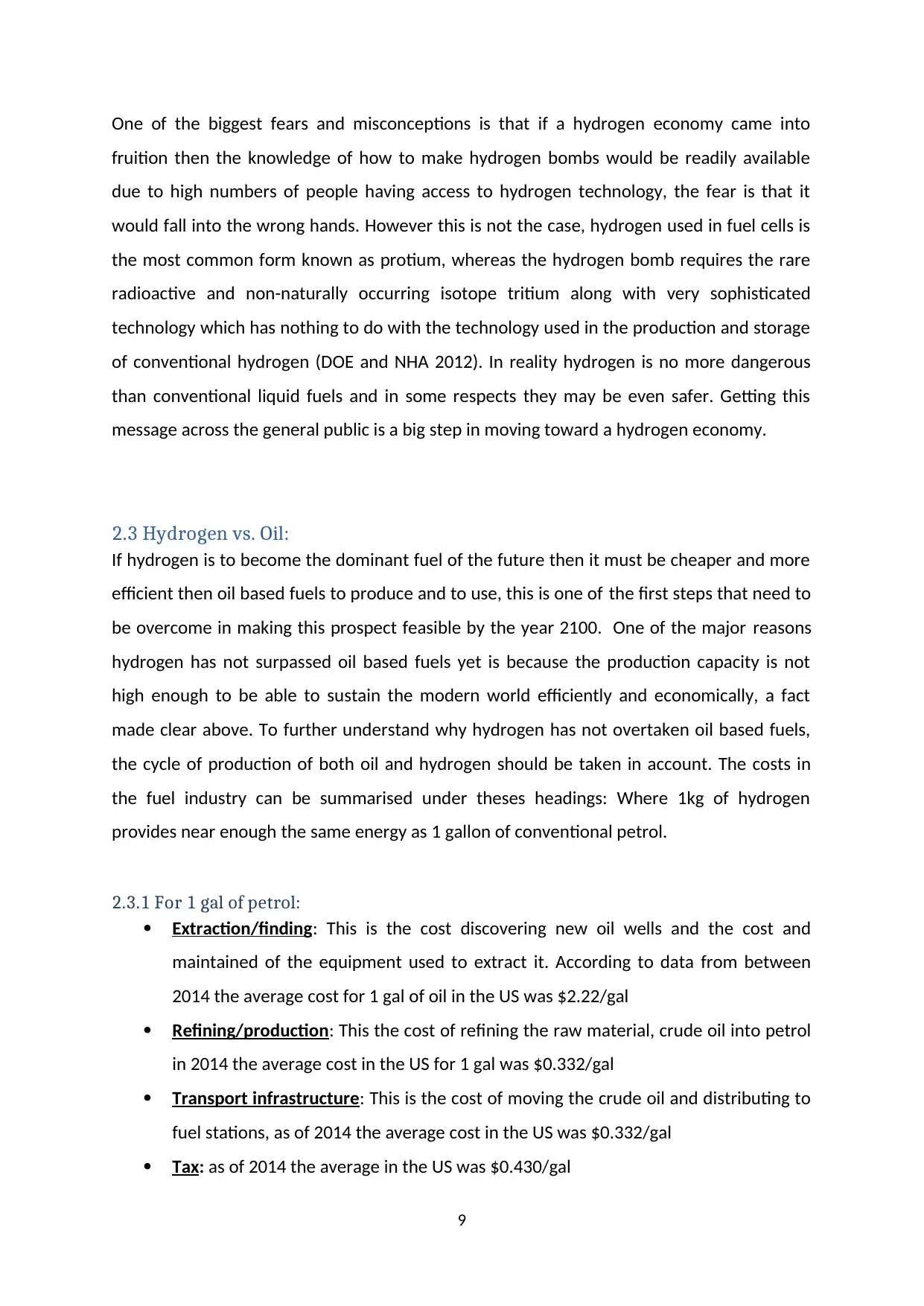
One of the biggest fears and misconceptions is that if a hydrogen economy came into
fruition then the knowledge of how to make hydrogen bombs would be readily available
due to high numbers of people having access to hydrogen technology, the fear is that it
would fall into the wrong hands. However this is not the case, hydrogen used in fuel cells is
the most common form known as protium, whereas the hydrogen bomb requires the rare
radioactive and non-naturally occurring isotope tritium along with very sophisticated
technology which has nothing to do with the technology used in the production and storage
of conventional hydrogen (DOE and NHA 2012). In reality hydrogen is no more dangerous
than conventional liquid fuels and in some respects they may be even safer. Getting this
message across the general public is a big step in moving toward a hydrogen economy.
2.3 Hydrogen vs. Oil:
If hydrogen is to become the dominant fuel of the future then it must be cheaper and more
efficient then oil based fuels to produce and to use, this is one of the first steps that need to
be overcome in making this prospect feasible by the year 2100. One of the major reasons
hydrogen has not surpassed oil based fuels yet is because the production capacity is not
high enough to be able to sustain the modern world efficiently and economically, a fact
made clear above. To further understand why hydrogen has not overtaken oil based fuels,
the cycle of production of both oil and hydrogen should be taken in account. The costs in
the fuel industry can be summarised under theses headings: Where 1kg of hydrogen
provides near enough the same energy as 1 gallon of conventional petrol.
2.3.1 For 1 gal of petrol:
Extraction/finding: This is the cost discovering new oil wells and the cost and
maintained of the equipment used to extract it. According to data from between
2014 the average cost for 1 gal of oil in the US was $2.22/gal
Refining/production: This the cost of refining the raw material, crude oil into petrol
in 2014 the average cost in the US for 1 gal was $0.332/gal
Transport infrastructure: This is the cost of moving the crude oil and distributing to
fuel stations, as of 2014 the average cost in the US was $0.332/gal
Tax: as of 2014 the average in the US was $0.430/gal
9
fruition then the knowledge of how to make hydrogen bombs would be readily available
due to high numbers of people having access to hydrogen technology, the fear is that it
would fall into the wrong hands. However this is not the case, hydrogen used in fuel cells is
the most common form known as protium, whereas the hydrogen bomb requires the rare
radioactive and non-naturally occurring isotope tritium along with very sophisticated
technology which has nothing to do with the technology used in the production and storage
of conventional hydrogen (DOE and NHA 2012). In reality hydrogen is no more dangerous
than conventional liquid fuels and in some respects they may be even safer. Getting this
message across the general public is a big step in moving toward a hydrogen economy.
2.3 Hydrogen vs. Oil:
If hydrogen is to become the dominant fuel of the future then it must be cheaper and more
efficient then oil based fuels to produce and to use, this is one of the first steps that need to
be overcome in making this prospect feasible by the year 2100. One of the major reasons
hydrogen has not surpassed oil based fuels yet is because the production capacity is not
high enough to be able to sustain the modern world efficiently and economically, a fact
made clear above. To further understand why hydrogen has not overtaken oil based fuels,
the cycle of production of both oil and hydrogen should be taken in account. The costs in
the fuel industry can be summarised under theses headings: Where 1kg of hydrogen
provides near enough the same energy as 1 gallon of conventional petrol.
2.3.1 For 1 gal of petrol:
Extraction/finding: This is the cost discovering new oil wells and the cost and
maintained of the equipment used to extract it. According to data from between
2014 the average cost for 1 gal of oil in the US was $2.22/gal
Refining/production: This the cost of refining the raw material, crude oil into petrol
in 2014 the average cost in the US for 1 gal was $0.332/gal
Transport infrastructure: This is the cost of moving the crude oil and distributing to
fuel stations, as of 2014 the average cost in the US was $0.332/gal
Tax: as of 2014 the average in the US was $0.430/gal
9
⊘ This is a preview!⊘
Do you want full access?
Subscribe today to unlock all pages.

Trusted by 1+ million students worldwide
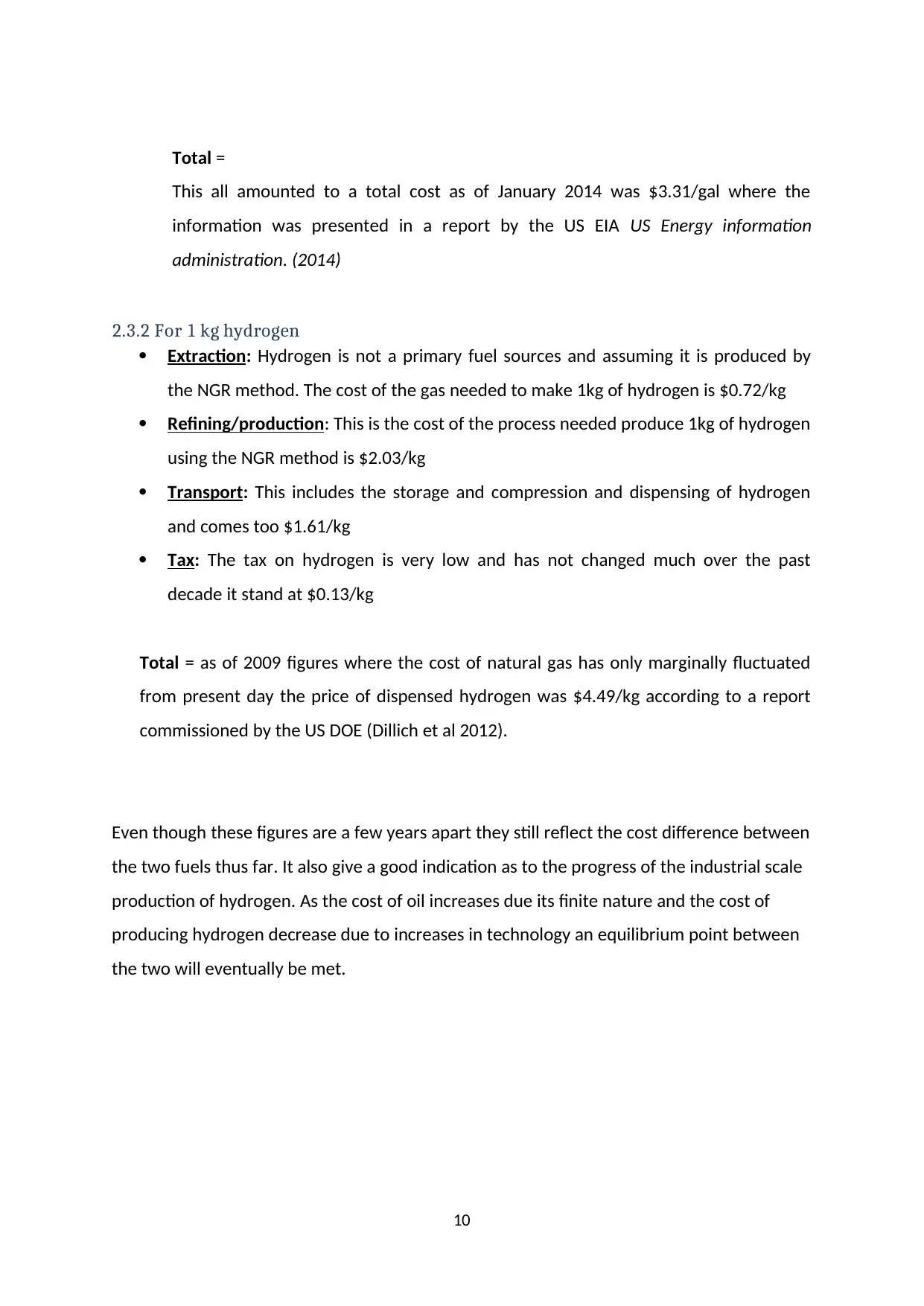
Total =
This all amounted to a total cost as of January 2014 was $3.31/gal where the
information was presented in a report by the US EIA US Energy information
administration. (2014)
2.3.2 For 1 kg hydrogen
Extraction: Hydrogen is not a primary fuel sources and assuming it is produced by
the NGR method. The cost of the gas needed to make 1kg of hydrogen is $0.72/kg
Refining/production: This is the cost of the process needed produce 1kg of hydrogen
using the NGR method is $2.03/kg
Transport: This includes the storage and compression and dispensing of hydrogen
and comes too $1.61/kg
Tax: The tax on hydrogen is very low and has not changed much over the past
decade it stand at $0.13/kg
Total = as of 2009 figures where the cost of natural gas has only marginally fluctuated
from present day the price of dispensed hydrogen was $4.49/kg according to a report
commissioned by the US DOE (Dillich et al 2012).
Even though these figures are a few years apart they still reflect the cost difference between
the two fuels thus far. It also give a good indication as to the progress of the industrial scale
production of hydrogen. As the cost of oil increases due its finite nature and the cost of
producing hydrogen decrease due to increases in technology an equilibrium point between
the two will eventually be met.
10
This all amounted to a total cost as of January 2014 was $3.31/gal where the
information was presented in a report by the US EIA US Energy information
administration. (2014)
2.3.2 For 1 kg hydrogen
Extraction: Hydrogen is not a primary fuel sources and assuming it is produced by
the NGR method. The cost of the gas needed to make 1kg of hydrogen is $0.72/kg
Refining/production: This is the cost of the process needed produce 1kg of hydrogen
using the NGR method is $2.03/kg
Transport: This includes the storage and compression and dispensing of hydrogen
and comes too $1.61/kg
Tax: The tax on hydrogen is very low and has not changed much over the past
decade it stand at $0.13/kg
Total = as of 2009 figures where the cost of natural gas has only marginally fluctuated
from present day the price of dispensed hydrogen was $4.49/kg according to a report
commissioned by the US DOE (Dillich et al 2012).
Even though these figures are a few years apart they still reflect the cost difference between
the two fuels thus far. It also give a good indication as to the progress of the industrial scale
production of hydrogen. As the cost of oil increases due its finite nature and the cost of
producing hydrogen decrease due to increases in technology an equilibrium point between
the two will eventually be met.
10
Paraphrase This Document
Need a fresh take? Get an instant paraphrase of this document with our AI Paraphraser
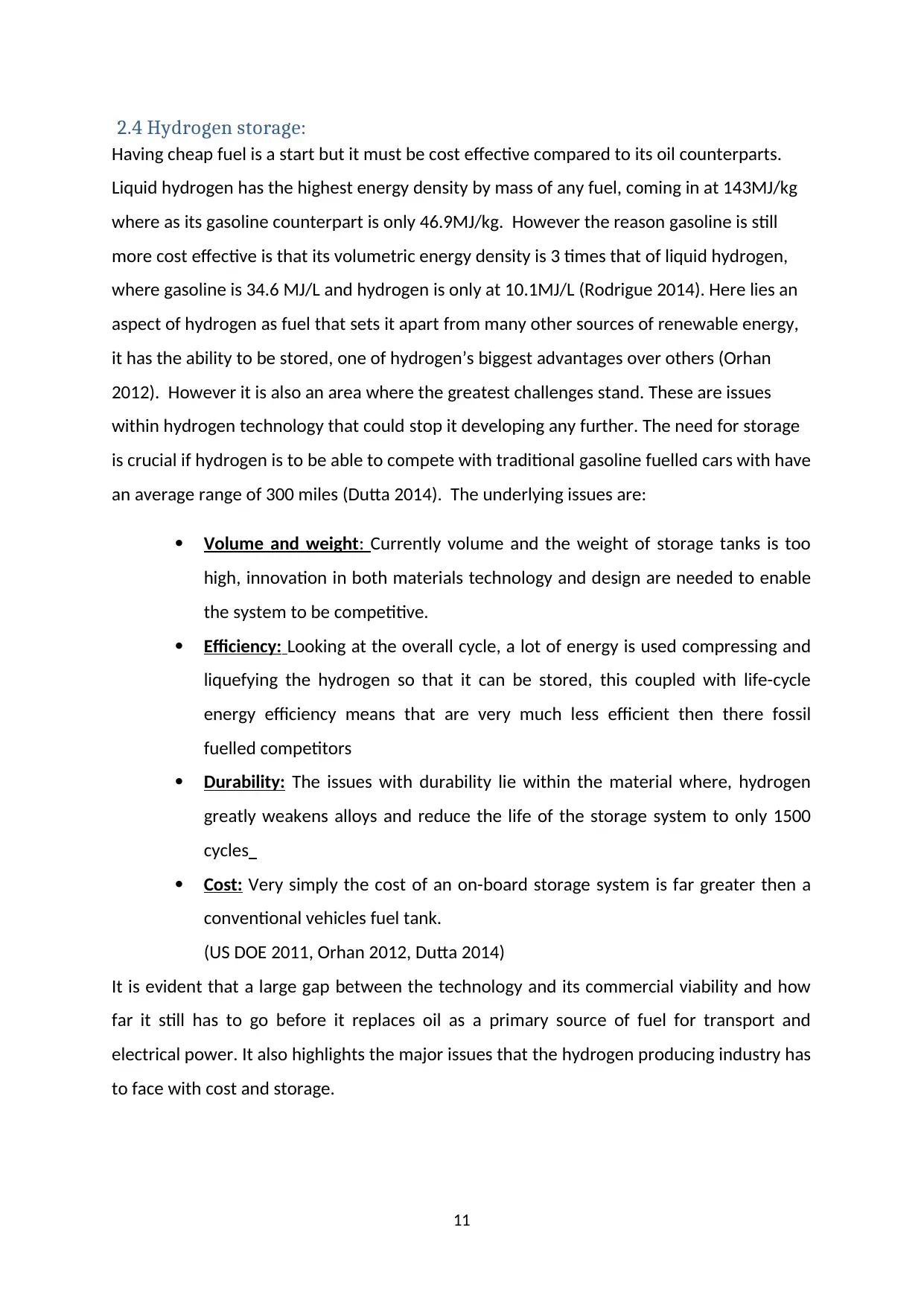
2.4 Hydrogen storage:
Having cheap fuel is a start but it must be cost effective compared to its oil counterparts.
Liquid hydrogen has the highest energy density by mass of any fuel, coming in at 143MJ/kg
where as its gasoline counterpart is only 46.9MJ/kg. However the reason gasoline is still
more cost effective is that its volumetric energy density is 3 times that of liquid hydrogen,
where gasoline is 34.6 MJ/L and hydrogen is only at 10.1MJ/L (Rodrigue 2014). Here lies an
aspect of hydrogen as fuel that sets it apart from many other sources of renewable energy,
it has the ability to be stored, one of hydrogen’s biggest advantages over others (Orhan
2012). However it is also an area where the greatest challenges stand. These are issues
within hydrogen technology that could stop it developing any further. The need for storage
is crucial if hydrogen is to be able to compete with traditional gasoline fuelled cars with have
an average range of 300 miles (Dutta 2014). The underlying issues are:
Volume and weight: Currently volume and the weight of storage tanks is too
high, innovation in both materials technology and design are needed to enable
the system to be competitive.
Efficiency: Looking at the overall cycle, a lot of energy is used compressing and
liquefying the hydrogen so that it can be stored, this coupled with life-cycle
energy efficiency means that are very much less efficient then there fossil
fuelled competitors
Durability: The issues with durability lie within the material where, hydrogen
greatly weakens alloys and reduce the life of the storage system to only 1500
cycles
Cost: Very simply the cost of an on-board storage system is far greater then a
conventional vehicles fuel tank.
(US DOE 2011, Orhan 2012, Dutta 2014)
It is evident that a large gap between the technology and its commercial viability and how
far it still has to go before it replaces oil as a primary source of fuel for transport and
electrical power. It also highlights the major issues that the hydrogen producing industry has
to face with cost and storage.
11
Having cheap fuel is a start but it must be cost effective compared to its oil counterparts.
Liquid hydrogen has the highest energy density by mass of any fuel, coming in at 143MJ/kg
where as its gasoline counterpart is only 46.9MJ/kg. However the reason gasoline is still
more cost effective is that its volumetric energy density is 3 times that of liquid hydrogen,
where gasoline is 34.6 MJ/L and hydrogen is only at 10.1MJ/L (Rodrigue 2014). Here lies an
aspect of hydrogen as fuel that sets it apart from many other sources of renewable energy,
it has the ability to be stored, one of hydrogen’s biggest advantages over others (Orhan
2012). However it is also an area where the greatest challenges stand. These are issues
within hydrogen technology that could stop it developing any further. The need for storage
is crucial if hydrogen is to be able to compete with traditional gasoline fuelled cars with have
an average range of 300 miles (Dutta 2014). The underlying issues are:
Volume and weight: Currently volume and the weight of storage tanks is too
high, innovation in both materials technology and design are needed to enable
the system to be competitive.
Efficiency: Looking at the overall cycle, a lot of energy is used compressing and
liquefying the hydrogen so that it can be stored, this coupled with life-cycle
energy efficiency means that are very much less efficient then there fossil
fuelled competitors
Durability: The issues with durability lie within the material where, hydrogen
greatly weakens alloys and reduce the life of the storage system to only 1500
cycles
Cost: Very simply the cost of an on-board storage system is far greater then a
conventional vehicles fuel tank.
(US DOE 2011, Orhan 2012, Dutta 2014)
It is evident that a large gap between the technology and its commercial viability and how
far it still has to go before it replaces oil as a primary source of fuel for transport and
electrical power. It also highlights the major issues that the hydrogen producing industry has
to face with cost and storage.
11
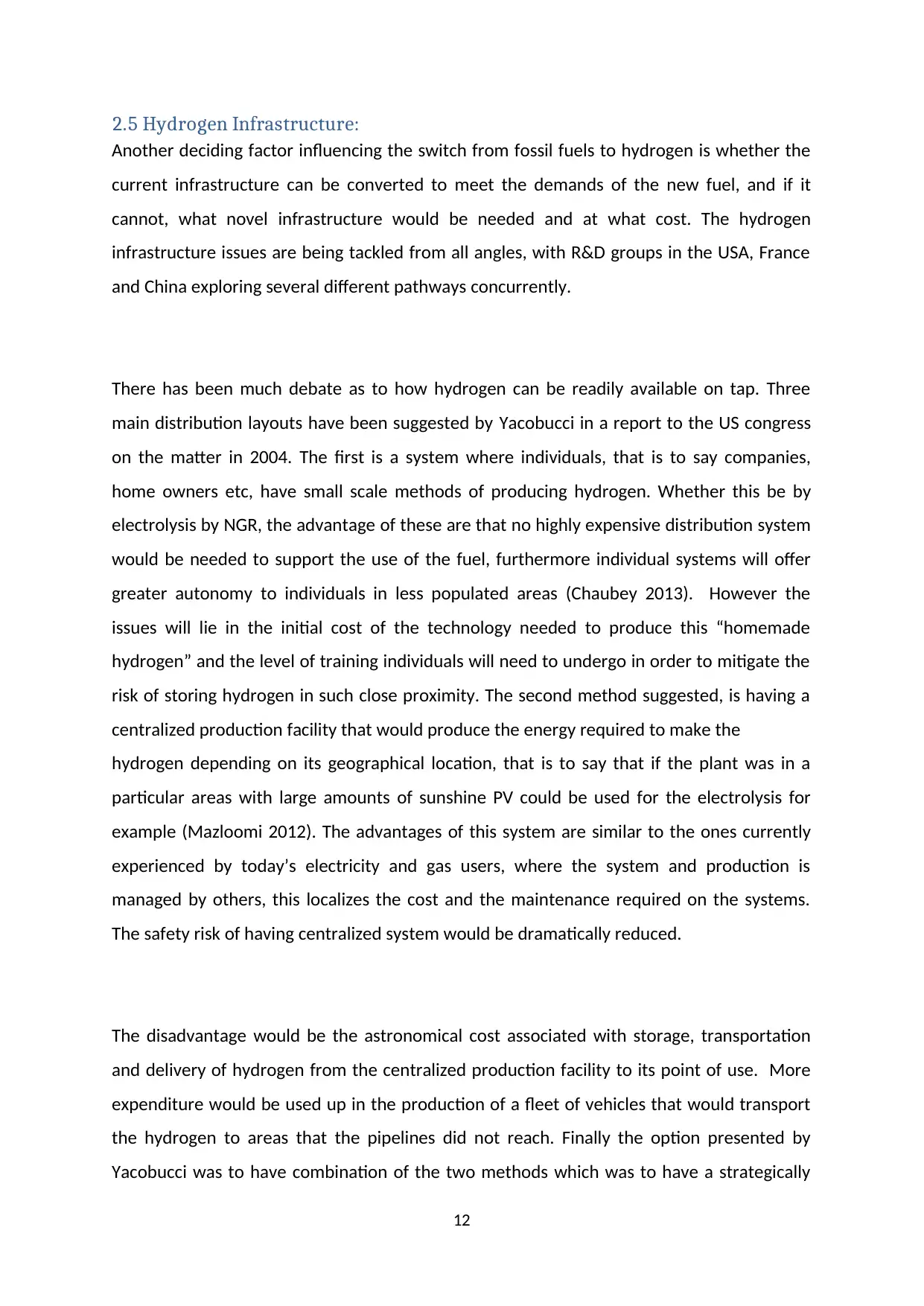
2.5 Hydrogen Infrastructure:
Another deciding factor influencing the switch from fossil fuels to hydrogen is whether the
current infrastructure can be converted to meet the demands of the new fuel, and if it
cannot, what novel infrastructure would be needed and at what cost. The hydrogen
infrastructure issues are being tackled from all angles, with R&D groups in the USA, France
and China exploring several different pathways concurrently.
There has been much debate as to how hydrogen can be readily available on tap. Three
main distribution layouts have been suggested by Yacobucci in a report to the US congress
on the matter in 2004. The first is a system where individuals, that is to say companies,
home owners etc, have small scale methods of producing hydrogen. Whether this be by
electrolysis by NGR, the advantage of these are that no highly expensive distribution system
would be needed to support the use of the fuel, furthermore individual systems will offer
greater autonomy to individuals in less populated areas (Chaubey 2013). However the
issues will lie in the initial cost of the technology needed to produce this “homemade
hydrogen” and the level of training individuals will need to undergo in order to mitigate the
risk of storing hydrogen in such close proximity. The second method suggested, is having a
centralized production facility that would produce the energy required to make the
hydrogen depending on its geographical location, that is to say that if the plant was in a
particular areas with large amounts of sunshine PV could be used for the electrolysis for
example (Mazloomi 2012). The advantages of this system are similar to the ones currently
experienced by today’s electricity and gas users, where the system and production is
managed by others, this localizes the cost and the maintenance required on the systems.
The safety risk of having centralized system would be dramatically reduced.
The disadvantage would be the astronomical cost associated with storage, transportation
and delivery of hydrogen from the centralized production facility to its point of use. More
expenditure would be used up in the production of a fleet of vehicles that would transport
the hydrogen to areas that the pipelines did not reach. Finally the option presented by
Yacobucci was to have combination of the two methods which was to have a strategically
12
Another deciding factor influencing the switch from fossil fuels to hydrogen is whether the
current infrastructure can be converted to meet the demands of the new fuel, and if it
cannot, what novel infrastructure would be needed and at what cost. The hydrogen
infrastructure issues are being tackled from all angles, with R&D groups in the USA, France
and China exploring several different pathways concurrently.
There has been much debate as to how hydrogen can be readily available on tap. Three
main distribution layouts have been suggested by Yacobucci in a report to the US congress
on the matter in 2004. The first is a system where individuals, that is to say companies,
home owners etc, have small scale methods of producing hydrogen. Whether this be by
electrolysis by NGR, the advantage of these are that no highly expensive distribution system
would be needed to support the use of the fuel, furthermore individual systems will offer
greater autonomy to individuals in less populated areas (Chaubey 2013). However the
issues will lie in the initial cost of the technology needed to produce this “homemade
hydrogen” and the level of training individuals will need to undergo in order to mitigate the
risk of storing hydrogen in such close proximity. The second method suggested, is having a
centralized production facility that would produce the energy required to make the
hydrogen depending on its geographical location, that is to say that if the plant was in a
particular areas with large amounts of sunshine PV could be used for the electrolysis for
example (Mazloomi 2012). The advantages of this system are similar to the ones currently
experienced by today’s electricity and gas users, where the system and production is
managed by others, this localizes the cost and the maintenance required on the systems.
The safety risk of having centralized system would be dramatically reduced.
The disadvantage would be the astronomical cost associated with storage, transportation
and delivery of hydrogen from the centralized production facility to its point of use. More
expenditure would be used up in the production of a fleet of vehicles that would transport
the hydrogen to areas that the pipelines did not reach. Finally the option presented by
Yacobucci was to have combination of the two methods which was to have a strategically
12
⊘ This is a preview!⊘
Do you want full access?
Subscribe today to unlock all pages.

Trusted by 1+ million students worldwide
1 out of 20
Related Documents
Your All-in-One AI-Powered Toolkit for Academic Success.
+13062052269
info@desklib.com
Available 24*7 on WhatsApp / Email
![[object Object]](/_next/static/media/star-bottom.7253800d.svg)
Unlock your academic potential
Copyright © 2020–2025 A2Z Services. All Rights Reserved. Developed and managed by ZUCOL.





